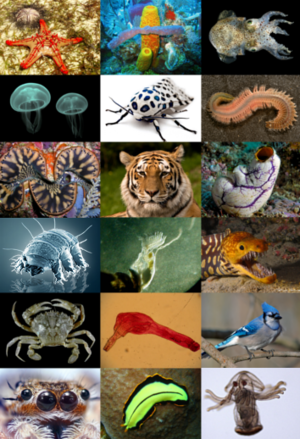
All animals are composed of cells, surrounded by a characteristic extracellular matrix composed of collagen and elastic glycoproteins.[12] During development, the animal extracellular matrix forms a relatively flexible framework upon which cells can move about and be reorganised, making the formation of complex structures possible. This may be calcified, forming structures such as shells, bones, and spicules.[13] In contrast, the cells of other multicellular organisms (primarily algae, plants, and fungi) are held in place by cell walls, and so develop by progressive growth.[14] Animal cells uniquely possess the cell junctions called tight junctions, gap junctions, and desmosomes.[15]
With few exceptions—in particular, the sponges and placozoans—animal bodies are differentiated into tissues.[16] These include muscles, which enable locomotion, and nerve tissues, which transmit signals and coordinate the body. Typically, there is also an internal digestive chamber with either one opening (as in flatworms) or two openings (as in deuterostomes).
Source: https://wikivisually.com/wiki/Animal
Not indicating that the content you copy/paste is not your original work could be seen as plagiarism.
Some tips to share content and add value:
Repeated plagiarized posts are considered spam. Spam is discouraged by the community, and may result in action from the cheetah bot.
Creative Commons: If you are posting content under a Creative Commons license, please attribute and link according to the specific license. If you are posting content under CC0 or Public Domain please consider noting that at the end of your post.
If you are actually the original author, please do reply to let us know!
Thank You!